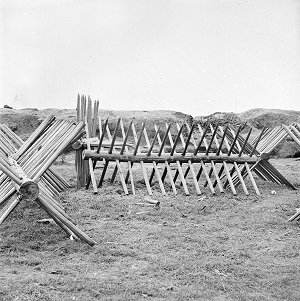Cheveaux de Fris

An anti-cavalry version of Chaveax de Fris, 1865
This PD image is available in even higher resolution at the Library of Congress
(Click the image for medium resolution)
In essence, cheveaux are hidden, sharp spikes used to impede cavalry or shipping. Cheveaux de frise literally translates as "horses of Friesland," a province in North Holland where the devices were first used.
The first line of defense against British ships coming up the Delaware River to attack American forts were cheveaux de frise. Designed by Robert Smith, a member of Philadelphia's Carpenters' Company, cheveaux were boxes about 40 feet by 60 feet crossed by timbers on which iron spikes were fastened. Weighted down by thirty tons of stone, the boxes were sunk into the river in such a way that the iron spikes pointed downstream at a five degree angle and remained just below the surface of the water at low tide. The hope was that British ships would have gashes ripped into their hulls as they passed over them.
Even if that scenario did not play out, the cheveaux would still proved a nuisance. Placed in close proximity to each other, the cheveaux still had to either be removed or "tilted" to allow the passage of British ships. Removal took a lot of time-consuming work.
A British officer described the American version of the cheveaux this way:
This kind of cheveaux de frise consists of large timbers, like the main mast of a ship, at the top of which are three branches armed and pointed with iron, spreading out fanwise...fifteen feet asunder. The main beam is fixt at an elevation to the frame of a float or stage, composed of vast logs, bound together as fast as possible; then covered with plank to the top and calked. When the machine is towed to its place, it is loaded with about thirty tuns of stones, secured in cases which, by taking the plugs out of the deck to admit the water into the float, sinks it down and keeps it firm and steady....the points of the branches are about six or seven feet under the surface of the water; and they spread in front thirty feet. A row of these cheveaux de frise are sunk sixty feet asunder from each other and another behind in their intervals, to form a range.



